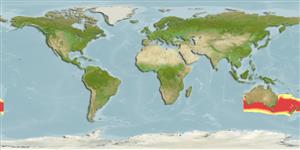Environment: milieu / climate zone / depth range / distribution range
Ekologi
laut; payau; kisaran kedalaman 22 - 500 m (Ref. 58489), usually ? - 150 m (Ref. 9072). Subtropical; 23°S - 50°S, 112°E - 176°W
Southwest Pacific: Australia and New Zealand waters. Two subpopulations probably exist in the Great Australian Bight and southeastern Australia, respectively, and two species or subspecies in the southeastern group (Ref. 7456).
Length at first maturity / Size / Weight / umur
Maturity: Lm 20.0 range ? - ? cm
Max length : 50.0 cm SL jantan/; (Ref. 33839); common length : 35.0 cm TL jantan/; (Ref. 9258); Umur maksimum dilaporkan: 25 Tahun (Ref. 9072)
Duri punggung (Keseluruhan (total)) : 9; duri punggung lunak (Keseluruhan (total)) : 27 - 33; Duri dubur: 3; Sirip dubur lunak: 22 - 29; vertebrata, bertulang belakang: 24. Adults are elongate and compressed, and have a primary lateral line with 67-81 scutes, a secondary lateral line reaching to dorsal-fin ray 2, and a yellow caudal fin.
Adults occur in coastal waters, including estuaries (Ref. 9563), mostly in waters shallower than 150 m and warmer than 13°C (Ref. 9072). Commonly found on the bottom, in midwater and occasionally at the surface (Ref. 9258), in large schools (Ref. 33616). Adults are generally found over offshore rocky reefs, while juveniles are generally found in shallow, soft substrate areas (Ref. 6390). Utilized fresh, smoked, canned and frozen; can be fried, broiled and baked (Ref. 9988).
Paxton, J.R., D.F. Hoese, G.R. Allen and J.E. Hanley, 1989. Pisces. Petromyzontidae to Carangidae. Zoological Catalogue of Australia, Vol. 7. Australian Government Publishing Service, Canberra, 665 p. (Ref. 7300)
Status IUCN Red List (Ref. 130435: Version 2024-1)
ancaman kepada manusia
Harmless
penggunaan manusia
Perikanan: komersial; Ikan buruan: ya; umpan: usually
Alat, peralatan
laporan khas
muat turun XML
Sumber internet
Estimates based on models
Preferred temperature (Ref.
123201): 13.1 - 21.2, mean 15.3 °C (based on 70 cells).
Phylogenetic diversity index (Ref.
82804): PD
50 = 0.5001 [Uniqueness, from 0.5 = low to 2.0 = high].
Bayesian length-weight: a=0.01778 (0.01021 - 0.03098), b=2.99 (2.84 - 3.14), in cm total length, based on LWR estimates for this species & Genus-body shape (Ref.
93245).
Trophic level (Ref.
69278): 3.2 ±0.40 se; based on food items.
Generation time: 3.7 ( na - na) years. Estimated as median ln(3)/K based on 2
growth studies.
Daya lenting (Ref.
120179): sedang, Waktu penggandaan populasi minimum 1.4 - 4.4 tahun (K=0.30; tm=3-4; tmax=25).
Fishing Vulnerability (Ref.
59153): Moderate vulnerability (37 of 100).
Nutrients (Ref.
124155): Calcium = 263 [161, 434] mg/100g; Iron = 3.76 [2.23, 6.42] mg/100g; Protein = 19.8 [19.0, 20.5] %; Omega3 = 0.383 [0.249, 0.578] g/100g; Selenium = 26.8 [14.7, 49.8] μg/100g; VitaminA = 8.05 [2.13, 29.13] μg/100g; Zinc = 2.37 [1.72, 3.33] mg/100g (wet weight);
